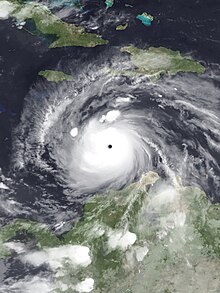 Felix at peak intensity north of Colombia, early on September 3 | |
| Meteorological history | |
|---|---|
| Formed | August 31, 2007 |
| Remnant low | September 5, 2007 |
| Dissipated | September 7, 2007 |
| Category 5 major hurricane | |
| 1-minute sustained (SSHWS/NWS) | |
| Highest winds | 175 mph (280 km/h) |
| Lowest pressure | 929 mbar (hPa); 27.43 inHg |
| Overall effects | |
| Fatalities | 133 |
| Damage | $720 million (2007 USD) |
| Areas affected | Trinidad and Tobago, Windward Islands, Venezuela, Leeward Antilles, Aruba, Colombia, Costa Rica, Nicaragua, Honduras, El Salvador, Belize, Guatemala, Mexico |
| IBTrACS | |
Part of the 2007 Atlantic hurricane season | |
Hurricane Felix was an extremely powerful Category 5 Atlantic hurricane which was the southernmost-landfalling Category 5 storm on record, surpassing Hurricane Edith of 1971. It was the sixth named storm, second hurricane, and second Category 5 hurricane of the 2007 Atlantic hurricane season. Felix formed from a tropical wave on August 31, passing through the southern Windward Islands on September 1 before strengthening to attain hurricane status. On the next day, Felix rapidly strengthened into a major hurricane, and early on September 3 it was upgraded to Category 5 status; at 2100 UTC on the same day, the hurricane was downgraded to Category 4 status, but strengthened into a Category 5 hurricane for the second and final time by the morning of September 4.
On September 4, Felix made landfall just south of the border between Nicaragua and Honduras, causing at least 133 deaths and hundreds of millions of dollars in damages in Central America. Because of its devastating impact on Central America, especially on Nicaragua, its name was retired after the 2007 season.